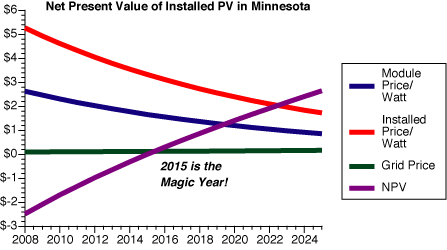The Magic Year
It's always dangerous to extrapolate current trends far into the future, but I've been doing it anyway for solar energy. I got my hands on a data set of the average price of photovoltaic modules over the past 25+ years (in constant 2006 dollars), thanks to Robert Margolis at NREL.
Keeping in mind that the data shows the prices of the PV modules only (not installation), the trend is remarkable: on average, the real price per watt of photovoltaic modules over the past 25 years has tracked almost perfectly to a curve which drops by half every 10.5 years (or about 6% per year). There are a few blips here and there--corresponding to supply and demand fluctuations--but the simple 6% annual drop in prices explains 96% of the variation in PV module cost over two and a half decades.
Given recent advances in photovoltaic technology, there's no reason to believe the trend won't continue for a while longer. It may even accelerate at some point.
At this point, it's natural to ask when solar panels will be cheaper than power from the electric company. You have to make some assumptions about the long term interest rate, how long the modules will last, and the relative cost of installation, and I came up with the answer that solar and grid power will be at parity somewhere between 2020 and 2025.
That's not the whole story, though, since it's reasonable to assume that the cost of electricity will increase faster than inflation for the foreseeable future. That means that while the cost of solar power is going down every year, the savings will go up--and the savings will continue to increase even after the solar panels are bought and paid for.
So in reality, it makes financial sense to install a photovoltaic system while it's still somewhat more expensive than grid power, since over the life of the system the savings will continue to increase. The Magic Year--the year when a brand-new photovoltaic system will pay for itself over its lifetime--depends on the assumptions you use about the inflation rate for electricity, the real interest rate, the life of the system, and so forth.
The Magic Year is 2015
The Magic Year is 2015 using these assumptions:
The installed price of a photovoltaic system will be twice the price of the modules alone
The price of the modules will continue to follow the historical curve
Grid power today costs $0.10/kWh (about the price I'm paying now)
The real inflation rate for grid power will be 3% (i.e. grid power will increase on average by 3% more than the inflation rate)
The long-term real interest rate will be 3.5% (i.e. the interest rate will be 3.5 percentage points above the inflation rate)
One watt of PV capacity will generate one kilowatt-hour of electricity per year (about the factor for Minnesota)
The system will last 30 years
After 30 years, the photovoltaic system will have no residual value (i.e. it will need to be completely replaced)
I used a Net Present Value (NPV) calculation, the standard way to figure the current value of future cash flow or savings. If the NPV is negative, then the system costs more to install than it saves over its lifetime; conversely, a positive NPV means the system pays for itself. The breakeven point (NPV = 0) is the Magic Year.
Your Magic Year may be different than mine. For example, in the California desert where grid power is more expensive and a photovoltaic system produces more power over a year, the Magic Year could be as early as 2007 (using the same interest rate and inflation assumptions). In Seattle, where hydro power is still cheap and it's cloudy all the time, the Magic Year could be 2025 or later.
Saving for the Magic Year
There are a lot of assumptions and an uncomfortable amount of extrapolation which go into calculating the Magic Year, but it seems reasonable to assume that 2015 will be the year to install a photovoltaic system here in Minnesota (give or take a couple years). She Who Puts Up With Me and I have decided to run with this assumption, and start putting aside some money every month with the idea of saving enough by 2015 to install a PV system big enough to bring our net electrical consumption to zero. We're also putting aside enough to pay for a major upgrade of our heating and air conditioning system at the same time--which might include switching to a geothermal heat pump.
In the meanwhile, we'll keep burning firewood in the winter--the stove has now paid for itself with gas savings--and doing smaller energy upgrades along the way like windows and lighting. 2015 is only seven years away, and by then we hope to have our net home energy use down to zero.

